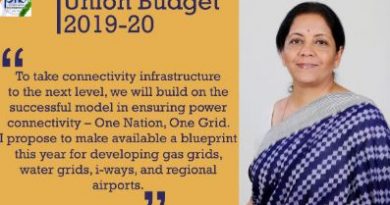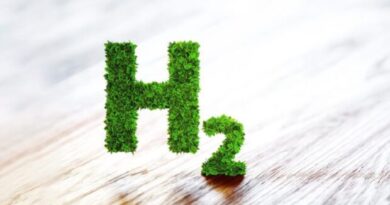Japan’s Sustainable Energy Challenge. The World Awaits
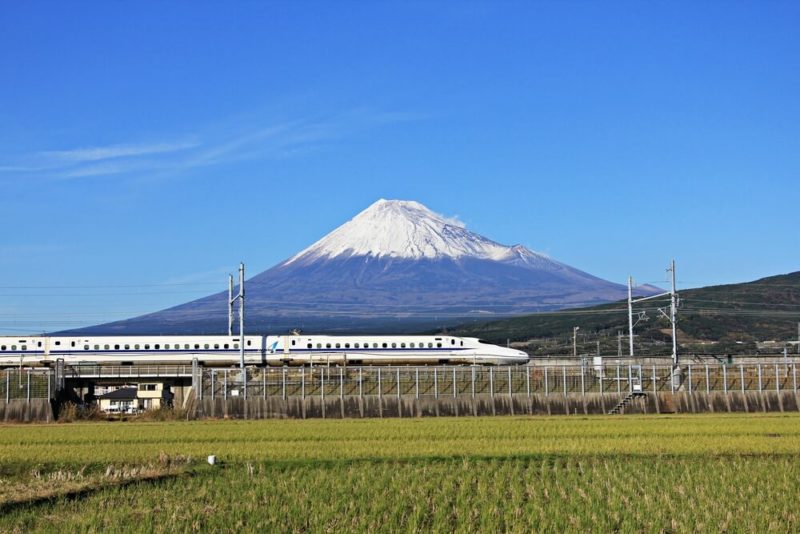 The best of everything?
The best of everything?
Japan, the world’s fifth biggest emitter of greenhouse gases, has got a long way to go to meets its renewable commitments. In the post-Fukushima era, local authorities around Japan are courting private investment in renewables as part of a push to dramatically increase their share of the national energy mix.
Pressure on Japan to increase renewables’ share of the energy mix means the number of large-scale solar farms is expected to rise. But, far from welcoming the dawn of a new age of clean energy on their doorstep, it has become the biggest concern for the Japanese.
Of all of the countries investing in renewables, few need the sort of fundamental rethink on energy policy as Japan, save perhaps France which remains nuclear dependent. The country recently marked the seventh anniversary of the tsunami disaster and Fukushima meltdown – which resulted in the closure of dozens of nuclear reactors – yet it still lags behind other countries in clean energy development. that is a position not likely to sit uncomfortably with the Japanese, who pride themselves on being ahead of the curve mostly.
According to the ministry of economy, trade and industry, renewable energy accounts for almost 18% of Japan’ energy mix but is dwarfed by coal at 34% and liquefied natural gas at almost 41%. LNG use of course shot up after the shut down of nuclear reactors.
In response, the government is aiming to increase renewables’ share to between 22% and 24% by 2030 – a target described as “ambitious” by the prime minister, Shinzo Abe. But is criticized by environmentalists who say that Japan’s 2030 pledge was woefully inadequate given that renewable energy already accounts for 24% of total global energy generation.
In terms of green electricity Japan is mostly dependent on hydro energy. With that in mind, other sources of renewable energy like wind, solar, geo-thermal, and bio-mass are still in the early stages of development.
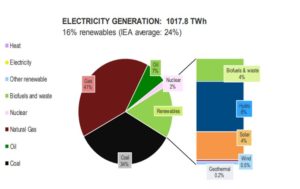
Figure shows the fragmentation of Japan’s electricity generation chart. Gas and Coal play a major role in generation of electricity followed by renewable energy. Liquefied National Gas (LNG) has also increased its share in the clean fossil fuel segment.
Japan has seen a deregulation in electricity which has enabled the users to choose the companies from which they can purchase electricity. But these companies are not required to display their source of power. As a result people opting for renewable energy won’t know which company to prefer.
With Japan’s focus towards construction of nuclear power supply, emphasis on hydro power took a backseat since 1990s. After the 2011 Fukushima disaster, in 2012 Japan started with Feed-in-Tariff (FIT). This system sees electric utilities and merchants purchase renewable energy-generated electricity at contract prices and durations as set by the Ministry of Economy, trade and Industry (METI). End users then pay a surcharge to help cover the renewable portion of the total power supply. Since its initiation the price of Fit has been constantly revised by the METI. Thanks to the introduction FIT in 2012, the installed capacity of renewable energy is growing rapidly.
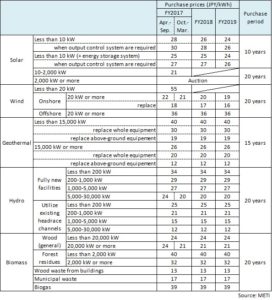
In 2014, Japan Community Power Association was established which aimed to create sustainable societies through community driven projects that promoted renewable energy.
Since the Paris Agreement, Japan has taken an active initiative by establishing Japan Climate Initiative in July 2018. The initiative came to existence with the participation of over 100 Japanese companies and NGOs in the light of the announcement of the Federal Government of USA to withdraw from the Paris Agreement, which saw over 2800 non-government companies, states and cities sprung up to leadership. The initiative aims to build a de-carbonised Japanese society.
Read: Japan’s Marubeni Exits Coal Power Business, to Halve Coal Generation Capacity
Even as it seeks answers, the country has, as usual, taken steps considered anathema in the so called developed world. Like running air conditioning inside offices at as high as 28-29 degrees, to conserve power. Or discouraging the use of ties in the government to make the higher temperatures palatable. In fact, this is the only country which has actively tried to cut down on power demand in absolute terms, even as other talk only about better productivity or sourcing from renewable sources.
To get the idea about its special situation, let’s look at the facts:
Area total: 377,973.89 km²
land: 364543.89 km² or 90080784 acres
water: 13,430 km²
Land boundaries: the ocean, no land borders
Coastline: 29,751 km (18,486 mi)
Climate: varies from tropical in south to cool temperate in north
Terrain: mostly rugged and mountainous, can easily be compared to Norway, both having about 70% of their land in the mountains.
Thus, finding good sites for solar at a decent cost is a huge challenge, though a long coastline would imply strong wind energy opportunities. A heavily industrialised economy also means the need for quality power, further making the switch challenging at a price that does not cripple local industry.
Now, for the factors that are specific to just Japan, ten percent of the world’s active volcanoes—forty in the early 1990s (another 148 were dormant)—are found in Japan, which lies in a zone of extreme crustal instability. As many as 1,500 earthquakes are recorded yearly, and magnitudes of 4 to 7 are common. Minor tremors occur almost daily in one part of the country or another, causing slight shaking of buildings. Major earthquakes occur infrequently. Another common hazard are several typhoons that reach Japan from the Pacific every year and heavy snowfall during winter in the snow country regions, causing landslides, flooding, and avalanches.
In its 2017 report on the industry, the Japan Renewable Energy Institute noted mounting concern about the impact mega plants were having on areas of natural and historical importance, echoing campaigners’ fears that the destruction of heavily wooded, mountainous land could increase the risk posed by floods and landslides.
Hence forth Japan has a very tough road ahead to decide how to diversify its energy mix. On one hand it has one of the highest population density, on the other land is scarce commodity on which its citizen and flora and fauna reside, which is often affected by earthquakes and typhoons. So, small or micro renewable power generating projects will be the need of the hour or adoption of clean fuel transport. Another demographic concern is the aging population, coupled with a reluctance to open up to immigrant workers. Which means these projects will have to be self-maintaining or require very little upkeep. Only such ideas and innovation will help Japanese solve the renewable energy conundrum in the coming future.

